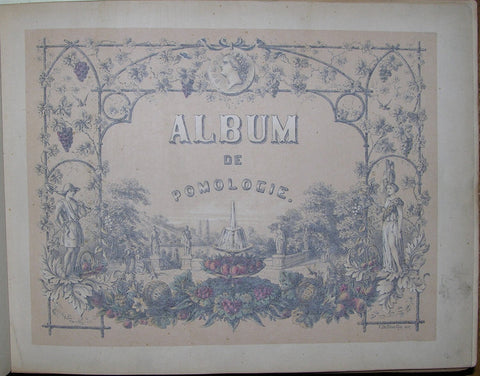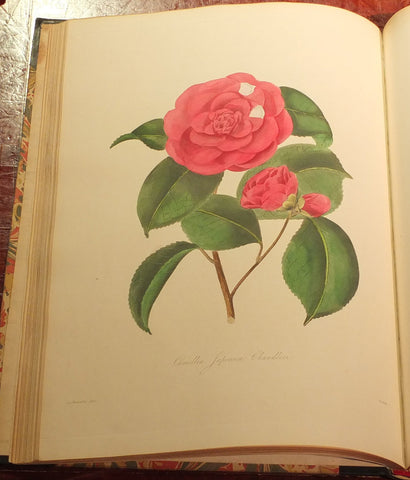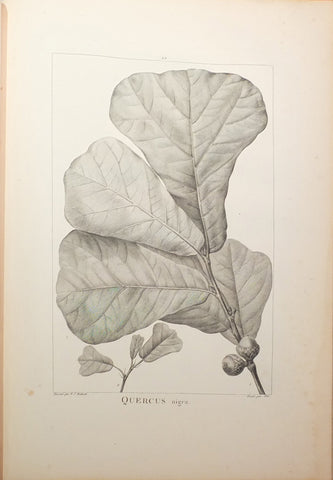Company School/Chinese School Album, [Drawings of Flowers]
Company School/Chinese School Album
[Drawings of Flowers]
Half dark green leather with maroon morocco grain cloth sides. Marbled endpapers
Oblong album. 19 ¼ x 16
Twenty-seven full-color watercolors on paper, some on pith paper
One pencil drawing on paper
Twenty pencil drawings on tracing paper
Provenance: Edward Smith Stanley, 13th Earl of Derby. Deaccessioned from the Knowlsey Collection. [The copper-plate armorial bookplate of Edward Smith Stanley, 13th Earl of Derby displaying a crown with an eagle and child has an interesting history. The eagle is grasping a swaddled child placed in a chapeau, or cap of maintenance turned up ermine. There is some speculation as to whether the eagle is preying on the child or protecting it. The crest passed on through the Stanley family ancestor the Lathams, and over time, several variations on the legend emerged. The first is that one of their ancestors abandoned an illegitimate son in an eagle’s nest, and the eagle having nurtured and fed him. From this extraordinary circumstance, another member of the family adopted him as his heir. In the second variation, the supposedly childless and elderly father arranged for the child to be placed in the eagle’s nest and “discovered” by a faithful retainer, allowing him to adopt the child without having to acknowledge paternity.]
DERBY, Edward Smith Stanley, 13 Earl of (only son of 12 Earl of Derby 1752–1834). b. 21 April 1775; ed. at Eton and Trin. coll. Cam., M.A. 1795; M.P. for Preston 1796–1812 and for Lancashire 1812–32; colonel 2 Lancashire militia 1 March 1797; created Baron Stanley of Bickerstaffe, co. palatine of Lancaster 22 Dec. 1832; succeeded his father 21 Oct. 1834; K.G. 2 April 1839; F.L.S. 1807, pres. 1828–34; pres. of Zoological Soc. 1831 to death; formed at Knowsley hall collections of living animals and birds, which far surpassed any menagerie or aviary previously attempted by a private person in this country, these collections were sold 6–11 Oct. 1851 for £7000; privately printed Gleanings from the menagerie and aviary at Knowsley hall 2 parts with 76 plates 1846–50. d. Knowsley hall 30 June 1851. P. Draper’s House of Stanley (1864) 275–82; Law Review xvi, 1–32 (1852); I.L.N. xix, 14, 405, 449 (1851).
In 1834 he succeeded his father as 13th Earl of Derby and withdrew from politics, instead of concentrating on his natural history collection at Knowsley Hall, near Liverpool. He was one of the most prominent natural historians of his day.
He lost no time in expanding the family collections and expanding it to be one unrivaled in Europe. These included, besides the live birds and mammals, a museum of zoological and botanical specimens, a library, and a vast collection of artworks depicting animals and plants. Together they constituted a research repository that he readily made available to other naturalists, including T. C. Eyton, J. E. Gray, and John Gould. At Lord Derby’s death in 1851, his museum collection, including many type specimens, was bequeathed to the City of Liverpool and led to the establishment of The Liverpool Museum.
The 13th Earl is also known for fostering the career of Edward Lear, one of the great animal artists and writers of the nineteenth century. Edward Lear wrote The Owl and the Pussycat for the Earl’s grandchildren.
or by email at loricohen@aradergalleries.
We Also Recommend

![Company School/Chinese School Album, [Drawings of Flowers]](http://aradergalleries.com/cdn/shop/products/VariousAsianorCompanySchoolArtists_drawingsofflowers_1_large.jpg?v=1591903087)
![Company School/Chinese School Album, [Drawings of Flowers]](http://aradergalleries.com/cdn/shop/products/VariousAsianorCompanySchoolArtists_drawingsofflowers_1_compact.jpg?v=1591903087)
![Company School/Chinese School Album, [Drawings of Flowers]](http://aradergalleries.com/cdn/shop/products/VariousAsianorCompanySchoolArtists_drawingsofflowers_2_compact.jpg?v=1591903102)
![Company School/Chinese School Album, [Drawings of Flowers]](http://aradergalleries.com/cdn/shop/products/VariousAsianorCompanySchoolArtists_drawingsofflowers_3_compact.jpg?v=1591903102)
![Company School/Chinese School Album, [Drawings of Flowers]](http://aradergalleries.com/cdn/shop/products/VariousAsianorCompanySchoolArtists_drawingsofflowers_4_compact.jpg?v=1591903102)
![Company School/Chinese School Album, [Drawings of Flowers]](http://aradergalleries.com/cdn/shop/products/VariousAsianorCompanySchoolArtists_drawingsofflowers_5_compact.jpg?v=1591903102)
![Company School/Chinese School Album, [Drawings of Flowers]](http://aradergalleries.com/cdn/shop/products/VariousAsianorCompanySchoolArtists_drawingsofflowers_6_compact.jpg?v=1591903102)
![Company School/Chinese School Album, [Drawings of Flowers]](http://aradergalleries.com/cdn/shop/products/VariousAsianorCompanySchoolArtists_drawingsofflowers_7_compact.jpg?v=1591903102)
![Company School/Chinese School Album, [Drawings of Flowers]](http://aradergalleries.com/cdn/shop/products/VariousAsianorCompanySchoolArtists_drawingsofflowers_8_compact.jpg?v=1591903102)
![Company School/Chinese School Album, [Drawings of Flowers]](http://aradergalleries.com/cdn/shop/products/VariousAsianorCompanySchoolArtists_drawingsofflowers_9_compact.jpg?v=1591903102)
![Company School/Chinese School Album, [Drawings of Flowers]](http://aradergalleries.com/cdn/shop/products/VariousAsianorCompanySchoolArtists_drawingsofflowers_10_compact.jpg?v=1591903102)
![Company School/Chinese School Album, [Drawings of Flowers]](http://aradergalleries.com/cdn/shop/products/VariousAsianorCompanySchoolArtists_drawingsofflowers_11_compact.jpg?v=1591903102)
![Company School/Chinese School Album, [Drawings of Flowers]](http://aradergalleries.com/cdn/shop/products/VariousAsianorCompanySchoolArtists_drawingsofflowers_12_compact.jpg?v=1591903102)
![Company School/Chinese School Album, [Drawings of Flowers]](http://aradergalleries.com/cdn/shop/products/VariousAsianorCompanySchoolArtists_drawingsofflowers_13_compact.jpg?v=1591903102)
![Company School/Chinese School Album, [Drawings of Flowers]](http://aradergalleries.com/cdn/shop/products/VariousAsianorCompanySchoolArtists_drawingsofflowers_14_compact.jpg?v=1591903102)
![Company School/Chinese School Album, [Drawings of Flowers]](http://aradergalleries.com/cdn/shop/products/VariousAsianorCompanySchoolArtists_drawingsofflowers_15_compact.jpg?v=1591903102)
![Company School/Chinese School Album, [Drawings of Flowers]](http://aradergalleries.com/cdn/shop/products/VariousAsianorCompanySchoolArtists_drawingsofflowers_16_compact.jpg?v=1591903102)
![Company School/Chinese School Album, [Drawings of Flowers]](http://aradergalleries.com/cdn/shop/products/VariousAsianorCompanySchoolArtists_drawingsofflowers_17_compact.jpg?v=1591903102)
![Company School/Chinese School Album, [Drawings of Flowers]](http://aradergalleries.com/cdn/shop/products/VariousAsianorCompanySchoolArtists_drawingsofflowers_18_compact.jpg?v=1591903102)
![Company School/Chinese School Album, [Drawings of Flowers]](http://aradergalleries.com/cdn/shop/products/VariousAsianorCompanySchoolArtists_drawingsofflowers_19_compact.jpg?v=1591903102)
![Company School/Chinese School Album, [Drawings of Flowers]](http://aradergalleries.com/cdn/shop/products/VariousAsianorCompanySchoolArtists_drawingsofflowers_20_compact.jpg?v=1591903102)
![Company School/Chinese School Album, [Drawings of Flowers]](http://aradergalleries.com/cdn/shop/products/VariousAsianorCompanySchoolArtists_drawingsofflowers_21_compact.jpg?v=1591903102)
![Company School/Chinese School Album, [Drawings of Flowers]](http://aradergalleries.com/cdn/shop/products/VariousAsianorCompanySchoolArtists_drawingsofflowers_22_compact.jpg?v=1591903102)
![Company School/Chinese School Album, [Drawings of Flowers]](http://aradergalleries.com/cdn/shop/products/VariousAsianorCompanySchoolArtists_drawingsofflowers_23_compact.jpg?v=1591903102)
![Company School/Chinese School Album, [Drawings of Flowers]](http://aradergalleries.com/cdn/shop/products/VariousAsianorCompanySchoolArtists_drawingsofflowers_24_compact.jpg?v=1591903102)
![Company School/Chinese School Album, [Drawings of Flowers]](http://aradergalleries.com/cdn/shop/products/VariousAsianorCompanySchoolArtists_drawingsofflowers_25_compact.jpg?v=1591903102)
![Company School/Chinese School Album, [Drawings of Flowers]](http://aradergalleries.com/cdn/shop/products/VariousAsianorCompanySchoolArtists_drawingsofflowers_26_compact.jpg?v=1591903102)
![Company School/Chinese School Album, [Drawings of Flowers]](http://aradergalleries.com/cdn/shop/products/VariousAsianorCompanySchoolArtists_drawingsofflowers_27_compact.jpg?v=1591903102)
![Company School/Chinese School Album, [Drawings of Flowers]](http://aradergalleries.com/cdn/shop/products/VariousAsianorCompanySchoolArtists_drawingsofflowers_28_compact.jpg?v=1591903102)
![Company School/Chinese School Album, [Drawings of Flowers]](http://aradergalleries.com/cdn/shop/products/VariousAsianorCompanySchoolArtists_drawingsofflowers_29_compact.jpg?v=1591903102)
![Company School/Chinese School Album, [Drawings of Flowers]](http://aradergalleries.com/cdn/shop/products/VariousAsianorCompanySchoolArtists_drawingsofflowers_30_compact.jpg?v=1591903102)
![Company School/Chinese School Album, [Drawings of Flowers]](http://aradergalleries.com/cdn/shop/products/VariousAsianorCompanySchoolArtists_drawingsofflowers_31_compact.jpg?v=1591903102)
![Company School/Chinese School Album, [Drawings of Flowers]](http://aradergalleries.com/cdn/shop/products/VariousAsianorCompanySchoolArtists_drawingsofflowers_32_compact.jpg?v=1591903102)
![Company School/Chinese School Album, [Drawings of Flowers]](http://aradergalleries.com/cdn/shop/products/VariousAsianorCompanySchoolArtists_drawingsofflowers_33_compact.jpg?v=1591903102)
![Company School/Chinese School Album, [Drawings of Flowers]](http://aradergalleries.com/cdn/shop/products/VariousAsianorCompanySchoolArtists_drawingsofflowers_34_compact.jpg?v=1591903103)
![Company School/Chinese School Album, [Drawings of Flowers]](http://aradergalleries.com/cdn/shop/products/VariousAsianorCompanySchoolArtists_drawingsofflowers_35_compact.jpg?v=1591903103)
![Company School/Chinese School Album, [Drawings of Flowers]](http://aradergalleries.com/cdn/shop/products/VariousAsianorCompanySchoolArtists_drawingsofflowers_36_compact.jpg?v=1591903103)
![Company School/Chinese School Album, [Drawings of Flowers]](http://aradergalleries.com/cdn/shop/products/VariousAsianorCompanySchoolArtists_drawingsofflowers_37_compact.jpg?v=1591903103)
![Company School/Chinese School Album, [Drawings of Flowers]](http://aradergalleries.com/cdn/shop/products/VariousAsianorCompanySchoolArtists_drawingsofflowers_38_compact.jpg?v=1591903103)
![Company School/Chinese School Album, [Drawings of Flowers]](http://aradergalleries.com/cdn/shop/products/VariousAsianorCompanySchoolArtists_drawingsofflowers_39_compact.jpg?v=1591903103)
![Company School/Chinese School Album, [Drawings of Flowers]](http://aradergalleries.com/cdn/shop/products/VariousAsianorCompanySchoolArtists_drawingsofflowers_40_compact.jpg?v=1591903103)
![Company School/Chinese School Album, [Drawings of Flowers]](http://aradergalleries.com/cdn/shop/products/VariousAsianorCompanySchoolArtists_drawingsofflowers_41_compact.jpg?v=1591903103)
![Company School/Chinese School Album, [Drawings of Flowers]](http://aradergalleries.com/cdn/shop/products/VariousAsianorCompanySchoolArtists_drawingsofflowers_42_compact.jpg?v=1591903103)




